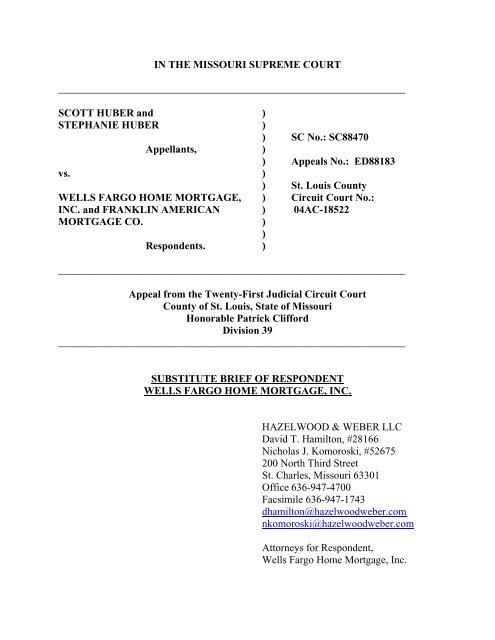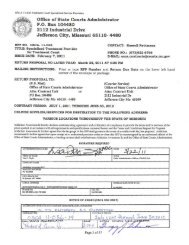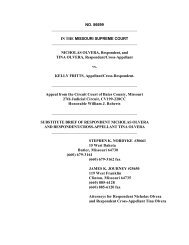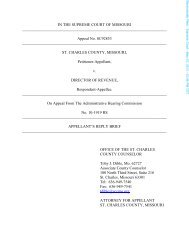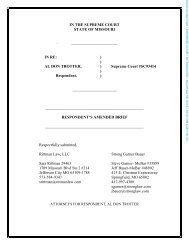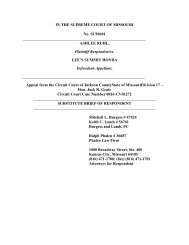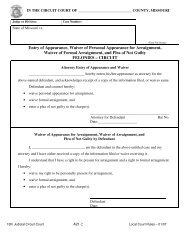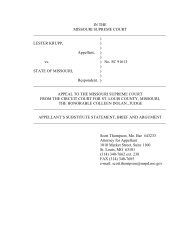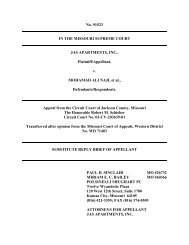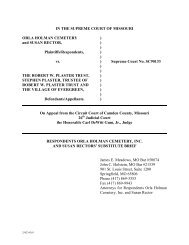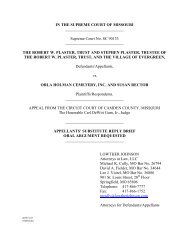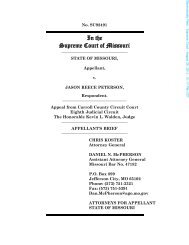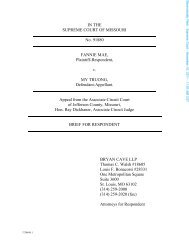IN THE MISSOURI SUPREME COURT SCOTT HUBER and ...
IN THE MISSOURI SUPREME COURT SCOTT HUBER and ...
IN THE MISSOURI SUPREME COURT SCOTT HUBER and ...
Create successful ePaper yourself
Turn your PDF publications into a flip-book with our unique Google optimized e-Paper software.
<strong>IN</strong> <strong>THE</strong> <strong>MISSOURI</strong> <strong>SUPREME</strong> <strong>COURT</strong><br />
__________________________________________________________________<br />
<strong>SCOTT</strong> <strong>HUBER</strong> <strong>and</strong> )<br />
STEPHANIE <strong>HUBER</strong> )<br />
) SC No.: SC88470<br />
Appellants, )<br />
) Appeals No.: ED88183<br />
vs. )<br />
) St. Louis County<br />
WELLS FARGO HOME MORTGAGE, ) Circuit Court No.:<br />
<strong>IN</strong>C. <strong>and</strong> FRANKL<strong>IN</strong> AMERICAN ) 04AC-18522<br />
MORTGAGE CO. )<br />
)<br />
Respondents. )<br />
__________________________________________________________________<br />
Appeal from the Twenty-First Judicial Circuit Court<br />
County of St. Louis, State of Missouri<br />
Honorable Patrick Clifford<br />
Division 39<br />
__________________________________________________________________<br />
SUBSTITUTE BRIEF OF RESPONDENT<br />
WELLS FARGO HOME MORTGAGE, <strong>IN</strong>C.<br />
HAZELWOOD & WEBER LLC<br />
David T. Hamilton, #28166<br />
Nicholas J. Komoroski, #52675<br />
200 North Third Street<br />
St. Charles, Missouri 63301<br />
Office 636-947-4700<br />
Facsimile 636-947-1743<br />
dhamilton@hazelwoodweber.com<br />
nkomoroski@hazelwoodweber.com<br />
Attorneys for Respondent,<br />
Wells Fargo Home Mortgage, Inc.
Table of Contents<br />
Table of Cases <strong>and</strong> Authorities…………………………………………………………. 3<br />
Jurisdictional Statement………………………………………………………................ 4<br />
Statement of Facts………………………………………………………………………. 6<br />
Points Relied On…..…………………………………………………………. ………… 9<br />
Argument……………………………………………………………………………….. 11<br />
I………………………………………………………………………………….. 11<br />
II…………………………………………………………………………………. 23<br />
III………………………………………………………………………………… 25<br />
Conclusion……………………………………………………………………………… 26<br />
Appendix ………………………………………………………………………………. 29<br />
Certificate of Counsel <strong>and</strong> Service……………………………………………………… 28<br />
2
Cases:<br />
Table of Authorities<br />
Berndsen v. Flagstar Bank, 193 S.W.3d 828 (Mo. App. E.D. 2006).…........................ 13<br />
Digman v. McCollum, 47 Mo. 372, 1871 WL 7647 (Mo. 1871).……………………. 15<br />
Garr v. Countrywide Home Loans, Inc., 137 S.W.3d 457 (Mo. banc 2004)...13, 16, 18, 22<br />
Glass v. First Nat. Bank of St. Louis 191 S.W.3d 662 (Mo. banc 2006) ………….. 17-18<br />
Huber v. Wells Fargo Home Mortgage, Inc., 2007 WL 656289 (Mo. App. E.D. 2007)… 4<br />
Husch & Eppenberger, LLC v. Eisenberg, 213 S.W.3d 124 (Mo. App. E.D. 2006) …… 18<br />
ITT Commercial Finance Corp. v. Mid-America Marine Supply Corp., 854 S.W.2d 371<br />
(Mo. banc 1993).……………………………………………………………………. 11-12<br />
Knutson v. Christeson, 684 S.W.2d 549 (Mo. App. S.D. 1984)……………………… 15<br />
Ringstreet Northcrest, Inc. v. Bisanz, 950 S.W.2d 520 (Mo. App. W.D. 1997)………. 23<br />
Roberts v. Rider, 924 S.W.2d 555 (Mo. App. S.D. 1996)……………………………... 13<br />
State ex inf. Dalton v. Miles Laboratories, Inc., 282 S.W.2d 564 (Mo. banc 1955) .. 18<br />
Constitutional Authority / Statutes:<br />
MO. CONST., ART. V, § 10 …………………………………………………………….. 5<br />
MO. REV. STAT. § 443.060 (2000) …………………………………………………….. 13<br />
MO. REV. STAT. § 443.130 (2000) ……………………………… 4, 7, 13-16, 19, 21, 23<br />
MO. REV. STAT. § 443.130 (Supp. 2004) ………………………………………… 20, 21<br />
Other:<br />
BLACK’S LAW DICTIONARY (7 th Ed. 1999) …………………………………………. 14<br />
3
Jurisdictional Statement<br />
This action involves Appellants’ claim of a violation of Section 443.130 of the<br />
Missouri Revised Statues (2000), 1 which requires mortgage companies to timely release<br />
deeds of trust encumbering property after payment in full of the loan secured by the<br />
property. Appellants contend that Respondents have a duty to provide Appellants with a<br />
deed of release after a statutory dem<strong>and</strong>, even though the property was no longer<br />
encumbered because a deed of release had been filed on the property in question before<br />
the dem<strong>and</strong> was received. See Legal File pp. 56-68. 2 On cross-motions for summary<br />
judgment, the Trial Court entered summary judgment against Appellants on April 27,<br />
2006 (L.F. 129-130) <strong>and</strong> Appellants filed their Notice of Appeal on May 26, 2006. L.F.<br />
138. The Missouri Court of Appeals reversed the Trial Court’s grant of summary<br />
judgment in favor of Wells Fargo <strong>and</strong> held that Section 443.130 requires a lending<br />
institution to provide a copy of a deed of release to that institution’s former borrower,<br />
even though the deed had already been released before any dem<strong>and</strong> had been served on<br />
the institution. See Huber v. Wells Fargo Home Mortgage, Inc., 2007 WL 656286 (Mo.<br />
App. E.D. 2007). By Order dated May 29, 2007, this Court sustained Wells Fargo Home<br />
Mortgage, Inc.’s Application for Transfer <strong>and</strong> ordered this appeal transferred to this<br />
Honorable Court.<br />
1. Unless stated otherwise, all further statutory references are to MO. REV. STAT. (2000).<br />
2. References to the Legal File will be to “L.F. ___.”<br />
4
This appeal falls within the jurisdiction of the Missouri Supreme Court pursuant to<br />
Article V, Section 10 of the Constitution of the State of Missouri, as this Court ordered<br />
the appeal transferred to this Court after opinion by the Court of Appeals due to the<br />
general interest or importance of a question involved in this appeal <strong>and</strong> because this<br />
Court may finally determine all causes coming to it from the court of appeals, whether by<br />
certification, transfer or certiorari, the same as on original appeal.<br />
5
Statement of Facts<br />
Respondent, Wells Fargo Home Mortgage, Inc. (“Wells Fargo”), is dissatisfied<br />
with the accuracy <strong>and</strong> completeness of Appellants’ Statement of Facts <strong>and</strong>, accordingly,<br />
submits the following:<br />
Appellants obtained a loan from Franklin American Mortgage Co. (“Franklin”)<br />
<strong>and</strong>, on September 12, 2002, executed a Deed of Trust in favor of Franklin, which was<br />
recorded at Book 14185 Page 2833 of the records of the Recorder of Deeds of St. Louis<br />
County, Missouri (the “Recorder of Deeds Office”). L.F. 25, 57-58. The original<br />
“mortgagee/beneficiary” on the Deed of Trust was “Mortgage Electronic Registration<br />
Systems, Inc. ‘MERS’ as nominee for Franklin American Mortgage Company.” L.F. 25,<br />
29, 58. Wells Fargo subsequently obtained the servicing rights to the Appellants’ loan.<br />
L.F. 108, 116.<br />
On February 6, 2004, Appellants paid the loan in full. The Deed of Trust securing<br />
the loan was then released by instrument (the “Deed of Release”) dated February 13,<br />
2004 <strong>and</strong> recorded on February 23, 2004 at Book 15651 Page 1789 of the Recorder of<br />
Deeds Office. L.F. 25, 33, 58.<br />
Fourteen days after the Deed of Release had been filed with the Recorder of Deeds<br />
Office, on March 8, 2004, Appellants sent Wells Fargo a letter signed by Scott E. Huber,<br />
which stated that “[w]e are making a statutory dem<strong>and</strong> for immediate release of the Deed<br />
of Trust against our Birmington Property;” Appellants also provided Wells Fargo with a<br />
check in the amount of $40.00. L.F. 81. Because the loan had been paid in full <strong>and</strong> the<br />
Deed of Trust had already been released, Wells Fargo returned the $40.00 check to the<br />
6
Appellants. L.F. 93. On April 23, 2004, Wells Fargo sent a second Deed of Release to<br />
Kevin L. Fritz. L.F. 94. This second Deed of Release, however, was unnecessary, as the<br />
property was no longer encumbered by a Deed of Trust <strong>and</strong> Wells Fargo did not then<br />
have, <strong>and</strong> in fact had never had, an interest of record in the property.<br />
On June 6, 2005, Appellants filed their First Amended Petition (the “Petition”)<br />
against Wells Fargo <strong>and</strong> Franklin. L.F. 11. In the Petition, Appellants alleged that Wells<br />
Fargo <strong>and</strong> Franklin had a statutory duty to provide Appellants with a deed of release<br />
within fifteen (15) days after receipt of Mr. Huber’s letter <strong>and</strong> that, upon a failure to do<br />
so, Appellants are entitled to 10% of the loan amount from the Respondents. L.F.11-14.<br />
Appellants’ Petition fails to mention that the property was not encumbered at the time<br />
Mr. Huber drafted his letter to Wells Fargo, or that the Deed of Release had been<br />
recorded before Mr. Huber delivered his letter.<br />
On June 23, 2005, Wells Fargo moved for summary judgment against Appellants,<br />
arguing that in order for Appellants’ to prevail, the property must have been encumbered<br />
by the Deed of Trust at the time Appellants made their alleged statutory dem<strong>and</strong>.<br />
Because it was undisputed that the property was not encumbered by the Deed of Trust at<br />
the time of the alleged statutory dem<strong>and</strong>, Wells Fargo asserted Section 443.130 was not<br />
implicated <strong>and</strong> judgment against Appellants was appropriate. Wells Fargo also noted that<br />
Section 443.130 states the that mortgagor must send the dem<strong>and</strong> letter “to the mortgagee,<br />
cestui qui trust, or assignee….” Under the Deed of Trust, Wells Fargo was not the<br />
mortgagee, cestui qui trust or assignee; Franklin was the mortgagee of record prior to<br />
7
elease of the Deed of Trust <strong>and</strong> it is undisputed that no letter requesting a deed of release<br />
had been sent to Franklin.<br />
By order dated April 27, 2006, the Trial Court granted summary judgment in favor<br />
of Wells Fargo <strong>and</strong> against Appellants. L.F. 129-130. On May 23, 2006, the Trial Court<br />
amended its order <strong>and</strong> also granted summary judgment in favor of Franklin <strong>and</strong> against<br />
Appellants. L.F. 137.<br />
8
Points Relied On<br />
I. The Trial Court did not err in granting Respondent’s Motion for Summary<br />
Judgment because no issue of material fact exists in that Section 443.130 is only<br />
applicable if, at the time Appellants made their dem<strong>and</strong> on Respondent, the<br />
property is encumbered by the Respondent’s Deed of Trust.<br />
MO. REV. STAT. § 443.060 (2000)<br />
MO. REV. STAT. § 443.130 (2000)<br />
Berndsen v. Flagstar Bank, 193 S.W.3d 828 (Mo. App. E.D. 2006)<br />
Digman v. McCollum, 47 Mo. 372, 1871 WL 7647 (Mo. 1871)<br />
Garr v. Countrywide Home Loans, Inc., 137 S.W.3d 457 (Mo. banc 2004)<br />
II. The Trial Court did not err in granting Respondent’s Motion for Summary<br />
Judgment because no issue of material fact exists in that Section 443.130 requires<br />
the mortgagor to serve a dem<strong>and</strong> on the “mortgagee, cestui qui trust, or assignee”<br />
under the Deed of Trust <strong>and</strong> Wells Fargo was not the mortgagee, cestui qui trust or<br />
assignee under the Deed of Trust.<br />
MO. REV. STAT. § 443.060 (2000)<br />
MO. REV. STAT. § 443.130 (2000)<br />
Ringstreet Northcrest, Inc. v. Bisanz, 950 S.W.2d 520 (Mo. App. W.D. 1997)<br />
9
III. The Trial Court did not err in granting Respondent’s Motion for Summary<br />
Judgment because no issue of material fact exists in that Section 443.130 is only<br />
applicable if, at the time Appellants made their dem<strong>and</strong> on Respondent, the<br />
property is encumbered by the Respondent’s Deed of Trust.<br />
MO. REV. STAT. § 443.060 (2000)<br />
MO. REV. STAT. § 443.130 (2000)<br />
Berndsen v. Flagstar Bank, 193 S.W.3d 828 (Mo. App. E.D. 2006)<br />
Digman v. McCollum, 47 Mo. 372, 1871 WL 7647 (Mo. 1871)<br />
Garr v. Countrywide Home Loans, Inc., 137 S.W.3d 457 (Mo. banc 2004)<br />
10
Argument<br />
I. The Trial Court did not err in granting Respondent’s Motion for Summary<br />
Judgment because no issue of material fact exists in that Section 443.130 is only<br />
applicable if, at the time Appellants made their dem<strong>and</strong> on Respondent, the<br />
property is encumbered by the Respondent’s Deed of Trust.<br />
A. St<strong>and</strong>ard of Review<br />
This Court’s review of the propriety of summary judgment is a question of law<br />
<strong>and</strong> therefore review is de novo. ITT Commercial Finance Corp. v. Mid-America Marine<br />
Supply Corp., 854 S.W.2d 371, 376 (Mo. banc 1993). The criteria for determining the<br />
propriety of summary judgment on appeal are no different than those used at the trial<br />
level. Id. This Court views the record <strong>and</strong> construes all inferences favorably to the non-<br />
movant, but facts set forth in support of the summary judgment motion are taken as true<br />
unless contradicted by the non-movant’s response. Id. at 376, 382-83.<br />
A defendant may establish a right to judgment by showing (1) facts that negate<br />
any one of the elements of the plaintiff’s claim, (2) that the plaintiff cannot produce<br />
evidence sufficient to allow the trier of fact to find the existence of any one of the<br />
plaintiff’s elements, or (3) “that there is no genuine dispute as to the existence of each of<br />
the facts necessary to support the [defendant’s] properly-pleaded affirmative defense.”<br />
Id. at 381.<br />
Once the defendant has met this burden, the plaintiff must show by reference to<br />
the record that “one or more of the material facts shown by the movant to be above any<br />
genuine dispute is, in fact, genuinely disputed.” Id.<br />
11
A “genuine issue” exists where the record contains competent materials that<br />
demonstrate “two plausible, but contradictory, accounts of the essential facts.” Id. at 382.<br />
B. The plain language of Section 443.130 (the “Penalty Statute”), as well<br />
as the purpose of the Penalty Statute, make clear that it is not applicable in a<br />
situation where the property is not encumbered by a deed of trust.<br />
The Penalty Statute, prior to its recent amendment, provided that:<br />
1. If any such person, thus receiving satisfaction, does not, within fifteen<br />
business days after request <strong>and</strong> tender of costs, deliver to the person making<br />
satisfaction a sufficient deed of release, such person shall forfeit to the party<br />
aggrieved ten percent upon the amount of the security instrument, absolutely, <strong>and</strong><br />
any other damages such person may be able to prove such person has sustained, to<br />
be recovered in any court of competent jurisdiction. A business day is any day<br />
except Saturday, Sunday <strong>and</strong> legal holidays.<br />
2. To qualify under this section, the mortgagor shall provide the request in the<br />
form of a dem<strong>and</strong> letter to the mortgagee, cestui qui trust, or assignee by certified<br />
mail, return receipt requested. The letter shall include good <strong>and</strong> sufficient evidence<br />
that the debt secured by the deed of trust was satisfied with good funds, <strong>and</strong> the<br />
expense of filing <strong>and</strong> recording the release was advanced.<br />
3. In any action against such person who fails to release the lien as provided in<br />
subsection 1 of this section, the plaintiff, or his attorney, shall prove at trial that<br />
the plaintiff notified the holder of the note by certified mail, return receipt<br />
requested.<br />
12
The Penalty Statute is the enforcement mechanism for Section 443.060.1, “which<br />
requires a mortgagee to deliver a ‘sufficient deed of release of the security instrument’<br />
upon satisfaction of the instrument.” Garr v. Countrywide Home Loans, Inc., 137<br />
S.W.3d 457, 460 (Mo. banc 2004) (quoting § 443.060.1).<br />
The purpose of the Penalty Statute is to ensure that encumbrances on real estate<br />
are released in a timely manner. See e.g., Garr, 137 S.W.3d at 460 (“[t]he purpose of<br />
section 443.130 is to enforce the duty of the mortgagee to clear the mortgagor’s title, so<br />
that the record is no longer encumbered”); Berndsen v. Flagstar Bank, 193 S.W.3d 828,<br />
831 (Mo. App. E.D. 2006) (“[t]he purpose of Section 443.130 is to enforce the duty of<br />
the mortgagee to clear the mortgagor’s title, so that the record is no longer encumbered”);<br />
Roberts v. Rider, 924 S.W.2d 555, 558 (Mo. App. S.D. 1996) (“The purpose of § 443.130<br />
is to enforce the duty of the mortgagee to clear the title of the mortgagor, so that it is<br />
apparent upon examination that the [e]ncumbrance of record no longer exits”) (internal<br />
quotations omitted).<br />
Appellants argue that even though their property was no longer encumbered by the<br />
Deed of Trust at the time of Mr. Huber’s dem<strong>and</strong> letter, the Penalty Statute still requires<br />
Wells Fargo to deliver a deed of release to the Appellants. Such an interpretation<br />
completely ignores the language <strong>and</strong> purpose of the Penalty Statute, which is to enforce<br />
the duty of the mortgagee to clear the mortgagor’s title. Without a need to clear the<br />
mortgagor’s title, there is no need for the enforcement mechanism of Section 443.130.<br />
The Penalty Statute provides that “[i]f any such person, thus receiving satisfaction,<br />
does not, within fifteen business days after request <strong>and</strong> tender of costs, deliver to the<br />
13
person making satisfaction a sufficient deed of release, such person shall forfeit to the<br />
party aggrieved ten percent upon the amount of the security instrument . . ..” § 443.130.1<br />
The Penalty Statute further explains that “[i]n any action against such person who fails to<br />
release the lien as provided in subsection 1 of this section, the plaintiff, or his attorney,<br />
shall prove at trial that the plaintiff notified the holder of the note by certified mail, return<br />
receipt requested.” § 443.130.3. (emphasis added).<br />
The language of section 443.130.3, which defines the mortgagor’s obligation to<br />
prove service of a dem<strong>and</strong> at a trial when the mortgagee “fails to release the lien . . ..”,<br />
<strong>and</strong> the holding of this Court, which clarified the purpose of section 443.130 as being “to<br />
clear the mortgagor’s title so that the record is no longer encumbered”, makes it<br />
apparent that the Penalty Statute does not apply to unencumbered property. If it did,<br />
as Appellants contend, any person that has owned property free <strong>and</strong> clear of a previously<br />
recorded mortgage could make a dem<strong>and</strong> on their prior lending institution for a deed of<br />
release, even if that property has been unencumbered for fifty years. There is no purpose<br />
in providing a deed of release to someone that owns unencumbered property.<br />
Furthermore, the Penalty Statutes states that “[t]o qualify under this section, the<br />
mortgagor shall provide the request in the form of a dem<strong>and</strong> letter to the mortgagee,<br />
cestui qui trust, or assignee by certified mail, return receipt requested.” § 443.130.2<br />
(emphasis added). “Mortgagor” is defined as “[o]ne who mortgages property; the<br />
mortgage-debtor, or borrower.” BLACK’S LAW DICTIONARY 1030 (7 th Ed. 1999). After<br />
the borrower has paid off his mortgage <strong>and</strong> the encumbrance is released, that party is no<br />
longer either a borrower or a mortgagor. That party owns his home free <strong>and</strong> clear <strong>and</strong> is<br />
14
no longer subject to a mortgage. To trigger the obligations of the Penalty Statute, “the<br />
mortgagor” must provide the secured party with a request in the form of a dem<strong>and</strong> letter.<br />
§ 443.130.2 (emphasis added). If the deed is released <strong>and</strong> the home is owned free <strong>and</strong><br />
clear of the encumbrance, there is no mortgagor. Accordingly, after Appellants paid off<br />
the mortgage <strong>and</strong> Franklin cleared its encumbrance on the Appellants’ home, the<br />
Appellants were no longer “mortgagors” <strong>and</strong>, therefore, lacked the status as “mortgagor”<br />
that is required to permit them to dem<strong>and</strong> a deed of release under the Penalty Statute.<br />
Also, under settled law, Appellants are deemed to have knowledge of the<br />
recordation of the Deed of Trust on February 23, 2004. In fact, the general rule is that a<br />
grantee is imputed with constructive notice of all duly recorded conveyances in the chain<br />
of title. See Digman v. McCollum, 47 Mo. 372, 1871 WL 7647, at *2 (Mo. 1871).<br />
The general rule on this subject undoubtedly is that a purchaser must at his own<br />
peril inquire into the state of his grantor’s record title, since he will be affected<br />
with constructive notice of all duly-recorded conveyances by his grantor affecting<br />
that title. I am aware of no exception to this rule….<br />
Digman, 1871 WL at *2.<br />
There can be no dispute that the general rule is still observed over 100 years after<br />
it was alluded to in Digman. See Knutson v. Christeson, 684 S.W.2d 549, 551 (Mo. App.<br />
S.D. 1984) (“We see no reason why the circumstances of this case warrant suspending<br />
application of the general rule that a grantee is charged with constructive notice of the<br />
contents of prior recorded instruments in his vendor's chain of title”) (emphasis added).<br />
The Appellants are the grantee under the Deed of Release <strong>and</strong> are otherwise functionally<br />
15
in the position of a grantee with regard to the chain of title. There is no logical reason<br />
why they should not be charged with constructive notice of all instruments in their chain<br />
of title prior to the date of their alleged statutory dem<strong>and</strong>. Appellants seek to recover a<br />
substantial statutory penalty that is, as a matter of law, only available if the deed of trust<br />
they seek to have removed from their chain of title is in fact in their chain of title. The<br />
fact that Appellants are imputed with constructive notice of the contents of prior recorded<br />
instruments in their chain of title deprives Appellants of the right to assert that they did<br />
not have notice that the Deed of Trust had in fact been released before the date of Mr.<br />
Huber’s alleged statutory dem<strong>and</strong>.<br />
It is undisputed that the Deed of Release of Franklin’s Deed of Trust was recorded<br />
on February 23, 2004, <strong>and</strong> that Mr. Huber made his dem<strong>and</strong> on March 8, 2004.<br />
Accordingly, Appellants’ property was unencumbered at the time of the dem<strong>and</strong>.<br />
Because the property was unencumbered, there was no “lien” for either Franklin or Wells<br />
Fargo to release <strong>and</strong> no encumbrance to “clear.” § 443.130.3; Garr, 137 S.W.3d at 460.<br />
As a result, Appellants’ claim failed to implicate the Penalty Statute <strong>and</strong> therefore failed<br />
as a matter of law. Accordingly, the Trial Court properly granted summary judgment in<br />
favor of Respondents <strong>and</strong> against Appellants.<br />
Furthermore, Appellants’ claim that Wells Fargo is attempting to graft additional<br />
requirements into Section 443.130 is incorrect. Appellants disingenuously argue that<br />
recording a deed of release is not the same as “delivering” the deed of release to the<br />
person making satisfaction. Whether recording a deed of release operates as a delivery is<br />
not the issue in this case. Appellants highlight the argument in an attempt to direct this<br />
16
Court’s attention away from the fact that Appellants’ property was not encumbered at the<br />
time of their dem<strong>and</strong>. If Appellants’ property was encumbered at the time of their<br />
dem<strong>and</strong> <strong>and</strong> if Wells Fargo recorded a deed of release instead of delivering a deed of<br />
release to the Appellants, then Appellants’ argument would be relevant. However, the<br />
argument is not relevant because no deed of trust encumbered the Appellants’ property at<br />
the time of the dem<strong>and</strong>. Consequently, Appellants’ claim under the Penalty Statute fails<br />
as a matter of law <strong>and</strong> summary judgment in favor of Wells Fargo <strong>and</strong> against Plaintiffs<br />
was appropriate.<br />
As such, the language in the Glass v. First Nat. Bank of St. Louis decision that<br />
“[e]ven if [the mortgage company] had recorded the deed of release within the statutory<br />
deadline, which it failed to do, that would not have excused its obligation to provide the<br />
[homeowers] with the deed as required by [S]ection 443.130.1,” does not require<br />
imposition of the statutory penalty for failure to provide a copy of the document that<br />
effectuated the release. 191 S.W.3d 662, 667 (Mo. banc 2006).<br />
In Glass, this Court reviewed only whether the borrowers’ letter sufficiently<br />
complied with the Penalty Statute so as to constitute a “dem<strong>and</strong>” under the Penalty<br />
Statute. Id. at 666 (“What [the lender] argues is that the contents of the dem<strong>and</strong> letter fail<br />
to sufficiently track the language of section 443.130 so as to provide adequate notice of<br />
the dem<strong>and</strong>”). This Court analyzed the dem<strong>and</strong> letter <strong>and</strong> found the letter sufficiently<br />
placed the lender on notice that a dem<strong>and</strong> was being made pursuant to the Penalty<br />
Statute. Id. at 666-67. Although neither essential to nor required to support its holding,<br />
this Court gratuitously stated that “[e]ven if [the lender] had recorded the deed of release<br />
17
within the statutory deadline, which it failed to do, that would not have excused its<br />
obligation to provide the [borrowers] with the deed as required by section 443.130.1.”<br />
Id. at 667 (emphasis added). Surely this statement was not intended to be construed to<br />
constitute an implicit intent to overrule this Court’s holding that the purpose of the<br />
Penalty Statute is to “enforce the duty of the mortgagee to clear the mortgagor’s title, so<br />
that the record is no longer encumbered.” Garr, 137 S.W.3d at 460.<br />
This Court requires that “[a]ny reported opinion should be read in light of the facts<br />
of that particular case <strong>and</strong> it would be unfair as well as improper to give permanent <strong>and</strong><br />
controlling effect to casual statements outside the scope of the real inquiry.” State ex inf.<br />
Dalton v. Miles Laboratories, Inc., 282 S.W.2d 564, 573 (Mo. banc 1955). “[D]icta” are<br />
statements “that [are] not essential to the Missouri Supreme Court’s decision.” Husch &<br />
Eppenberger, LLC v. Eisenberg, 213 S.W.3d 124, 132 (Mo. App. E.D. 2006). Such<br />
statements are not binding. Id. As such, the dicta in the Glass decision possibly<br />
requiring physical delivery of the original deed of release—not a copy—in a case where a<br />
statutory dem<strong>and</strong> is made, <strong>and</strong> the property is encumbered at the time of the dem<strong>and</strong>, is<br />
not binding on this Court.<br />
Furthermore, the decision in Glass did not address the issue now before this Court.<br />
In Glass, the borrower served a dem<strong>and</strong> letter on the lender <strong>and</strong>, at the time the dem<strong>and</strong><br />
letter was served, the property in question was encumbered by the lender’s deed of trust.<br />
Glass, 191 S.W.3d at 664. Here, there is no dispute Appellants’ home was not<br />
encumbered at the time Mr. Huber sent his letter dem<strong>and</strong>ing a release of his Deed of<br />
Trust. The property in Glass was encumbered at the time of the dem<strong>and</strong>, thus triggering<br />
18
the enforcement mechanism of the Penalty Statute. Here, the Penalty Statute could not<br />
have been triggered by service of Mr. Huber’s letter after the Deed of Trust was released.<br />
See § 443.130.3 (“[i]n any action against such person who fails to release the lien as<br />
provided in subsection 1 of this section”) (emphasis added). Accordingly, Glass is<br />
neither binding on this Court nor is it relevant to the issue before the Court.<br />
The dicta in the Glass decision could be construed as requiring a lender to both<br />
record an original executed deed of release <strong>and</strong> provide an original executed deed of<br />
release to the borrower if the dem<strong>and</strong> is served on the lender before the lender has<br />
recorded a deed of release on the property. That scenario is simply not the case here.<br />
Here, no encumbrance existed on the Appellants’ property at the time of their dem<strong>and</strong>.<br />
The language of the Penalty Statute <strong>and</strong> this Court’s holding in Garr establish that the<br />
obligations contained in the Penalty Statute cannot be triggered unless the property<br />
subject to the dem<strong>and</strong> is encumbered at the time of the dem<strong>and</strong>. Otherwise, the Penalty<br />
Statute’s purpose—to enforce the mortgagee’s duty to timely release its encumbrance—is<br />
cast aside <strong>and</strong> the Penalty Statute simply provides a potential windfall for savvy<br />
plaintiffs.<br />
Moreover, to construe the Glass decision as requiring lending institutions to<br />
provide a “copy” of a previously filed deed of release to a former borrower imposes<br />
substantial burdens upon those lending institutions. Such an opinion would be construed<br />
as requiring lenders to comply with the Penalty Statute even after the<br />
mortgagee/mortgagor (lender/borrower) relationship has concluded. This would unduly<br />
burden lenders because after a lender records a deed of release (<strong>and</strong> it does so before a<br />
19
dem<strong>and</strong> is made under the Penalty Statute), the lender should be able to close out that<br />
borrower’s file. Instead, the lender must maintain those files for an indefinite period of<br />
time <strong>and</strong> record <strong>and</strong> deliver a “copy” of a deed of release to any former borrower that<br />
makes a dem<strong>and</strong> under the Penalty Statute.<br />
C. Amendment of the Statute Does Not Affect the General Interest <strong>and</strong><br />
Importance of the Question Presented.<br />
The revision to the Penalty Statute does not obviate the problem that a lender may<br />
be required to comply with the Penalty Statute years after it has recorded a deed of<br />
release on a property <strong>and</strong> moved the files for that property to an off-site location.<br />
The Penalty Statute, as amended, states:<br />
If the secured party, receiving satisfaction for the debt secured pursuant to this<br />
chapter, does not, within forty-five days after request <strong>and</strong> tender of costs, submit<br />
for recording a sufficient deed of release, such secured party shall be liable to the<br />
mortgagor….<br />
MO. REV. STAT. § 443.130.1 (Supp. 2004) (hereinafter the “Revised Penalty Statute”).<br />
Under the Revised Penalty Statute, a lender must “submit for recording a sufficient deed<br />
of release” within forty-five days after a dem<strong>and</strong> by a borrower even if the lender had<br />
already, prior to the dem<strong>and</strong>, recorded a deed of release.<br />
Neither the Penalty Statute nor the Revised Penalty Statute provide a date on<br />
which a lender will no longer have any duties under the statutes. It is logical that a lender<br />
will no longer owe any duties to a borrower after the borrower has paid off the loan <strong>and</strong><br />
the lender has released its encumbrance; it is likewise logical that the only way a lender’s<br />
20
obligations under the Penalty Statute <strong>and</strong> the Revised Penalty Statute could be triggered<br />
is if the borrower’s dem<strong>and</strong> is made before the lender records a deed of release.<br />
Construing dicta in Glass to require lenders to provide copies of deeds of release after<br />
any dem<strong>and</strong> for a deed of release is made, even if the deed of release was recorded before<br />
the dem<strong>and</strong>, will place a heavy burden on lenders. Lenders would have an obligation to<br />
provide a deed of release on property that the lender may have already released years<br />
before. That is clearly not the purpose of either the Penalty Statute or the Revised<br />
Penalty Statute.<br />
A finding that a lender’s obligations cease after it has recorded its deed of release,<br />
if the Penalty Statute or Revised Penalty Statute are not triggered before then by a proper<br />
dem<strong>and</strong>, is logical. If the statutes have not been triggered <strong>and</strong> the encumbrance released,<br />
the borrower is no longer a “mortgagor.” Instead, that party owns his home free <strong>and</strong> clear<br />
<strong>and</strong> is no longer subject to a mortgage. To trigger the obligations of the Penalty Statute<br />
<strong>and</strong> the Revised Penalty Statute, “the mortgagor” must provide the secured party with a<br />
request in the form of a dem<strong>and</strong> letter. § 443.130.2 (emphasis added); § 443.130.3<br />
(Supp. 2004) (emphasis added). If the deed is released <strong>and</strong> the home is owned free <strong>and</strong><br />
clear of the encumbrance, there is no mortgagor. There is only a person who was once a<br />
mortgagor—the Penalty Statute <strong>and</strong> Revised Penalty Statute should not be interpreted as<br />
requiring a never-ending duty on lenders to provide deeds of release to former borrowers.<br />
D. Conclusion<br />
For Appellants’ claim to succeed, this Court would have to recognize that it would<br />
be possible under the Penalty Statute for anyone to dem<strong>and</strong> a deed of release from their<br />
21
prior mortgagee, even if that mortgagee had filed a deed of release on the property years<br />
ago. This would require mortgage companies to maintain records regarding properties<br />
that they have no interest in, for an indefinite amount of time. Moreover, it would be<br />
necessary for the records to be immediately assessable, as a strict delivery deadline is<br />
applicable under both the Penalty Statute <strong>and</strong> the Revised Penalty Statute. Under the<br />
clear language of the Penalty Statute, <strong>and</strong> this Court’s explanation of the Penalty Statute’s<br />
purpose, this could not have been the Legislature’s intent. If it were, Appellants would<br />
actually have an incentive to wait as long as possible before dem<strong>and</strong>ing a deed of release.<br />
The longer they wait, the more likely that their mortgagee will convert their records to<br />
microfiche or place their records in a bulk storage area, thereby making it more difficult<br />
for the mortgagee to comply with the dem<strong>and</strong>.<br />
The purpose of section 443.130 “is to enforce the duty of the mortgagee to clear<br />
the mortgagor’s title so that the record is no longer encumbered” (Garr, 137 S.W.3d at<br />
460 (emphasis added)), not to provide a legal game of “gotcha” for savvy Plaintiffs. At<br />
the time of Appellants’ dem<strong>and</strong>, no encumbrance claimed by Wells Fargo or Franklin<br />
burdened the property. As such, the Penalty Statute was not implicated <strong>and</strong> Appellants’<br />
claim fails as a matter of law.<br />
22
II. The Circuit Court did not err in granting Respondents’ Motion for Summary<br />
Judgment because no issue of material fact exists in that Section 443.130 requires<br />
the mortgagor to serve a dem<strong>and</strong> on the “mortgagee, cestui qui trust, or assignee”<br />
under the Deed of Trust <strong>and</strong> Wells Fargo was not the mortgagee, cestui qui trust or<br />
assignee under the Deed of Trust.<br />
A. St<strong>and</strong>ard of Review<br />
The st<strong>and</strong>ard of review applicable to this point relied on is the same as discussed<br />
above at section I, pages 12 <strong>and</strong> 13.<br />
B. Appellants failed to serve a dem<strong>and</strong> pursuant to Section 443.130 to the<br />
mortgagee, cestui qui trust or assignee.<br />
In order for Appellants’ claim under the Penalty Statute to be successful,<br />
Appellants must show that they made their dem<strong>and</strong> for a deed of release to the<br />
“mortgagee, cestui qui trust, or assignee.” § 443.130.2. Appellants cannot show that<br />
Wells Fargo is the “mortgagee, cestui qui trust, or assignee” under the Deed of Trust.<br />
The undisputed evidence is that the Deed of Trust provides that Franklin is the<br />
mortgagee, not Wells Fargo. Because Appellants cannot prove that they provided the<br />
required statutory dem<strong>and</strong> to the “mortgagee, cestui qui trust, or assignee,” their claim<br />
fails as a matter of law.<br />
C. Conclusion<br />
The Penalty Statute is to be strictly construed, <strong>and</strong> adherence with all requirements<br />
of the Penalty Statute is required before liability will be imposed. Ringstreet Northcrest,<br />
Inc. v. Bisanz, 950 S.W.2d 520, 522 (Mo. App. W.D. 1997).<br />
23
As noted in paragraph 2 of the Penalty Statute, the mortgagor is required to<br />
provide the request for release in the form of a dem<strong>and</strong> letter to “the mortgagee, cestui<br />
qui trust, or assignee.” Under the Deed of Trust, Franklin was the mortgagee of record.<br />
Appellants, however, failed to serve their dem<strong>and</strong> on Franklin. 3 Because Appellants<br />
failed to comply with the terms of Section 443.130, their claim fails as a matter of law.<br />
3 Wells Fargo concedes that it received an assignment of some rights created by the Deed<br />
of Trust. It is undisputed, however, that there was no change of the applicable real estate<br />
records to reflect Wells Fargo’s interest. Given the state of the real estate records, it is<br />
clear that only Franklin, or Franklin’s nominee, could effectively release the interest<br />
created by the Deed of Trust—as it did by filing a deed of release on February 23, 2004.<br />
24
III. The Circuit Court did not err in granting Respondents’ Motion for<br />
Summary Judgment because no issue of material fact exists in that Section 443.130<br />
is only applicable if, at the time Appellants made their dem<strong>and</strong> on Respondents, the<br />
property is encumbered by the Respondents’ Deed of Trust.<br />
In response to Appellants’ third Point Relied On, Wells Fargo hereby incorporates<br />
its arguments set forth in response to Appellants’ first Point Relied On, pages 12 through<br />
23, as though fully set forth herein.<br />
25
Conclusion<br />
Because the Deed of Trust had been released prior to the date of Appellants’<br />
alleged statutory dem<strong>and</strong>, their claim fails as a matter of law. The Penalty Statute is<br />
intended to assure that encumbrances that have in fact been satisfied are no longer<br />
reflected in the official real estate records as encumbrances. Because the Deed of Trust<br />
had been released prior to the date of Appellants’ dem<strong>and</strong>, the statute was never<br />
implicated. Furthermore, Appellants’ attempt to create a cause of action by submitting a<br />
statutory dem<strong>and</strong> under circumstances in which the dem<strong>and</strong> was not authorized because<br />
they were not mortgagors cannot create such a cause of action. In addition, Appellants<br />
failed to comply with the Penalty Statute because they did not send their purported<br />
statutory dem<strong>and</strong> to the “mortgagee, cestui qui trust, or assignee.”<br />
For the reasons aforesaid, there is no genuine dispute of material fact <strong>and</strong> the Trial<br />
Court’s grant of summary judgment was proper. Accordingly, Wells Fargo respectfully<br />
requests that this Court affirm the decision of the Trial Court.<br />
26
27<br />
Respectfully submitted,<br />
HAZELWOOD & WEBER LLC<br />
By:___________________________<br />
David T. Hamilton, #28166<br />
Nicholas J. Komoroski, #52675<br />
200 North Third Street<br />
St. Charles, Missouri 63301<br />
Office 636-947-4700<br />
Facsimile 636-947-1743<br />
dhamilton@hazelwoodweber.com<br />
nkomoroski@hazelwoodweber.com<br />
Attorneys for Respondent,<br />
Wells Fargo Home Mortgage, Inc.
Certificate of Counsel <strong>and</strong> Service of Brief<br />
I hereby certify that Respondent’s Substitute Brief on Appeal complies with the<br />
limitations contained in Rule 84.06(b) <strong>and</strong> that there are 5,513 words in the Substitute<br />
Brief, excluding the cover, certificate of service, signature block <strong>and</strong> appendix. A floppy<br />
disk containing a copy of Respondent’s Substitute Brief on Appeal is attached <strong>and</strong> I<br />
hereby certify that said floppy disk has been scanned for viruses <strong>and</strong> is virus-free. I<br />
further certify that two (2) true copies of the Respondent’s Substitute Brief on Appeal <strong>and</strong><br />
a floppy disk containing a copy of the brief were mailed, postage prepaid, this 6th day of<br />
July 2007, to Kevin Fritz, 714 Locust Street, St. Louis, MO 63101 <strong>and</strong> Charles F.<br />
DuFour, 8011 Clayton Road, 3 rd Floor, St. Louis, MO 63117 <strong>and</strong> state that ten (10)<br />
copies of Respondent’s Brief were mailed via Federal Express, overnight shipping, to the<br />
Missouri Supreme Court, this 6th day of July 2007.<br />
28<br />
HAZELWOOD & WEBER LLC<br />
By:___________________________<br />
David T. Hamilton, #28166<br />
Nicholas J. Komoroski, #52675<br />
200 North Third Street<br />
St. Charles, Missouri 63301<br />
Office 636-947-4700<br />
Facsimile 636-947-1743<br />
dhamilton@hazelwoodweber.com<br />
nkomoroski@hazelwoodweber.com<br />
Attorneys for Respondent,<br />
Wells Fargo Home Mortgage, Inc.
Appendix<br />
29
Statutes:<br />
Appendix Table of Contents<br />
MO. REV. STAT. § 443.060 (2000) …………………………………………………….. 1<br />
MO. REV. STAT. § 443.130 (2000) …………………………………………………….. 3<br />
MO. REV. STAT. § 443.130 (Supp. 2004) ……………………………………………… 4<br />
30


